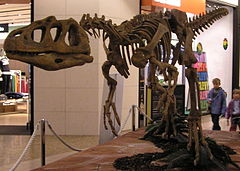
Back بياتنيتسكيصور Arabic Piatnitzkysaure Catalan Piatnitzkysaurus Czech Piatnitzkysaurus German Piatnitzkysaurus English Piatnitzkysaurus floresi Spanish Piatnitzkysaurus Finnish Piatnitzkysaurus French פיאטניצקיזאורוס HE Piatnitzkysaurus Croatian
| Piatnitzkysaurus floresi | |
| Bonaparte, 1979 | |
 szkielet piatnickizaura | |
| Systematyka | |
| Domena | |
|---|---|
| Królestwo | |
| Typ | |
| Podtyp | |
| Gromada | |
| Podgromada | |
| (bez rangi) | archozaury |
| Nadrząd | |
| Rząd | |
| Podrząd | |
| Infrarząd | |
| Nadrodzina | |
| Rodzina | |
| Rodzaj |
piatnickizaur |
| Gatunek |
Piatnitzkysaurus floresi |
Piatnickizaur (Piatnitzkysaurus floresi) – drapieżny teropod z kladu tetanurów (Tetanurae).
Żył w okresie jury (ok. 165 mln lat temu) na terenach Ameryki Południowej. Długość ciała ok. 5 m, masa do 400 kg. Jego szczątki znaleziono w Argentynie (prowincja Chubut).
Pierwotnie Piatnitzkysaurus był zaliczany do rodziny allozaurów. Obecnie jego pozycja filogenetyczna jest niepewna; z analiz kladystycznych wynika, że mógł być przedstawicielem rodziny Megalosauridae[2], przedstawicielem nadrodziny Megalosauroidea nienależącym do rodziny Megalosauridae[3][4][1] lub przedstawicielem kladu Tetanurae bardziej bazalnym niż megalozauroidy[5][6].
- ↑ a b Matthew T. Carrano, Roger B. J. Benson i Scott D. Sampson. The phylogeny of Tetanurae (Dinosauria: Theropoda). „Journal of Systematic Palaeontology”. 10 (2), s. 211–300, 2012. DOI: 10.1080/14772019.2011.630927. (ang.).
- ↑ T. R. Holtz, R. E. Molnar, P. J. Currie: Basal Tetanurae. W: David B. Weishampel, Peter Dodson, Halszka Osmólska (red.): The Dinosauria. Wyd. drugie. Berkeley: University of California Press, 2004, s. 71-110. ISBN 0-520-24209-2.
- ↑ Roger B. J. Benson, Matthew T. Carrano, Stephen L. Brusatte. A new clade of archaic large-bodied predatory dinosaurs (Theropoda: Allosauroidea) that survived to the latest Mesozoic. „Naturwissenschaften”. 97 (1), s. 71-78, 2010. DOI: 10.1007/s00114-009-0614-x. (ang.).
- ↑ Roger B. J. Benson. A description of Megalosaurus bucklandii (Dinosauria: Theropoda) from the Bathonian of the UK and the relationships of Middle Jurassic theropods. „Zoological Journal of the Linnean Society”. 158 (4), s. 882-935, 2010. DOI: 10.1111/j.1096-3642.2009.00569.x. (ang.).
- ↑ Oliver W. M. Rauhut. The interrelationships and evolution of basal theropod dinosaurs. „Special Papers in Palaeontology”. 69, s. 1–213, 2003. (ang.).
- ↑ Nathan D. Smith, Peter J. Makovicky, William R. Hammer, Philip J. Currie. Osteology of Cryolophosaurus ellioti (Dinosauria: Theropoda) from the Early Jurassic of Antarctica and implications for early theropod evolution. „Zoological Journal of the Linnean Society”. 151 (2), s. 377–421, 2007. DOI: 10.1111/j.1096-3642.2007.00325.x. (ang.).